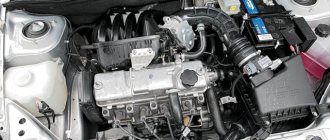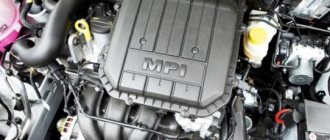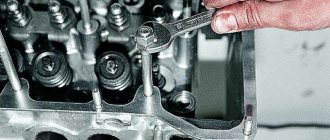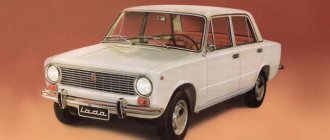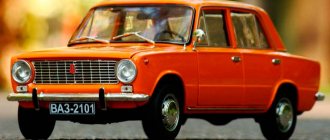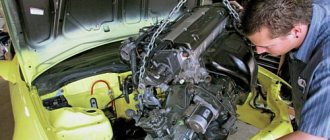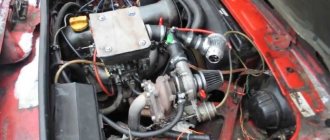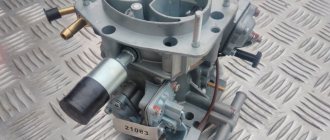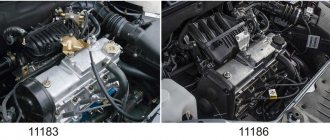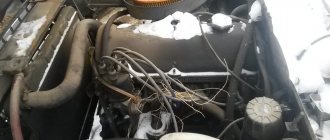Replacing piston rings
On VAZ cars, as well as on all other models of passenger cars, it is advisable to change only the piston rings only if:
- there is no exhaust in the cylinders;
- there are no signs of damage to their inner surface.
If the liners are significantly worn, they need to be bored, and if the last size was already used before, the cylinder block needs to be relined. You can replace the PC on any VAZ engine without removing the internal combustion engine; this will require removing the cylinder head and oil sump. PCs are replaced if the gap at the joints does not exceed 1 mm.
For example, let's consider replacing piston rings on a VAZ-2114 car with an 8-valve internal combustion engine; such work must be carried out on a pit or a car lift:
- turn off the ignition, put the gearbox in neutral, disconnect the negative terminal from the battery;
- drain the antifreeze, remove the air filter housing along with the pipe (injector corrugation);
- remove the valve cover, camshaft, loosen the timing belt and move it to the side;
- disconnect the H/V wires and cooling system pipes from the cylinder head, unscrew the head bolts;
- unscrew the nuts of the exhaust pipe of the muffler;
- We completely free the cylinder head from all fasteners that prevent it from being removed, and we remove the cylinder head;
- if there is protection under the engine, remove it;
- place a container under the engine sump, unscrew the plug on the crankcase, drain the oil;
- remove the lower hatch of the gearbox housing (three bolts);
- Using a 10 mm wrench or a socket wrench, unscrew all the oil pan bolts;
- dismantle the pan, remove the oil receiver;
- Unscrew the connecting rod nuts, remove the lower connecting rod caps, and carefully knock the pistons and connecting rods upward. Pistons should be knocked out through a soft metal drift or through a wooden block. First, you need to carefully knock out the connecting rod bolt without damaging the threads on it, then place the drift on the end of the connecting rod - in no case should you hit the bearings or the seat underneath them;
- It is recommended to remove the connecting rods one at a time, and immediately attach the caps to them; the caps should not be confused with each other, they are placed back strictly in their places, and a lock to the lock is required;
- remove the PC from the pistons, use a piece of the old ring to clean the piston grooves to bare metal. Be sure to check the cleanliness of the groove all around; there should be no coke left in it;
- We install new rings in the grooves, start with the lower MPC, then install the middle compression PK, and lastly the upper one. For installation, you can use a special device, but it is still more convenient to install the rings by hand. If the MPCs are cast iron, they cannot be bent along their axis, they can only be carefully moved apart. Compression rings also need to be bent carefully, to a minimum;
- we install the piston in place using a special mandrel, hammer it in with a wooden hammer handle or a brass or bronze drift;
- We install one piston-rod at a time, and immediately attach a connecting rod cap to each one. The connecting rod nuts should be tightened with a torque wrench, force - from 4.5 to 5.5 kg;
- then we put everything in place - the oil receiver, the engine sump, the cylinder head. We fill the radiator with antifreeze, oil into the crankcase, and start the engine to check. After replacing the PC, the internal combustion engine may initially smoke and consume oil - the engine needs to be run in for approximately 2 thousand km. It happens that despite the seemingly normal condition of the liners, the internal combustion engine continues to smoke even after replacing the rings after break-in. In this case, you will have to bore the cylinders and install a repair piston group.
Pistons - replacement
To complete the work, you will need mandrels to remove the piston pin and compress the rings.
1. Place the car on an inspection hole or overpass (see “Preparing the car for maintenance and repair”).
2. Remove the cylinder head from the engine (see “Cylinder head gasket - replacement”).
3. Remove the engine sump (see “Engine sump - removal and installation”).
4. Unscrew the nuts of the connecting rod caps (without removing the crankshaft) and push the piston and connecting rod out of the cylinder block (see “Crankshaft - removal and installation”).
5. Remove the steel-aluminum liner from the connecting rod cover.
The connecting rod and cap are stamped with the number of the cylinder in which they are installed.
6. Place the connecting rod in a vice and remove two compression rings and one oil scraper ring with an expander from the piston.
7. Press the pin out of the connecting rod through the mandrel and remove the piston.
Similarly, remove the pistons of the remaining cylinders.
Before installing the piston group on the connecting rod, it is necessary to select its parts.
Selection of connecting rod and piston parts
1. Select the piston to the cylinder. The calculated gap between the cylinder and the engine piston should be 0.06-0.08 mm. It is determined by measuring the cylinders and pistons and is ensured by installing pistons of the same class as the cylinders. The maximum permissible gap is 0.15 mm. The piston diameter is measured in a plane perpendicular to the piston pin, at a distance of 52.4 mm from the piston bottom. The outer diameter of the pistons is made into five classes (A, B, C, D and E) every 0.01 mm, and the diameter of the hole for the piston pin is made into three categories every 0.004 mm. Spare parts include pistons of groups A, C and E. The piston class (letter) and the category of the piston pin hole (number) are stamped on the piston bottom.
Pistons and connecting rods.VAZ-— DRIVE2
Pressing out the piston pin.
Selection of piston to cylinder.
The calculated gap between the piston and cylinder (for new parts) is 0.025-0.045 mm. It is determined by measuring the parts and is ensured by installing pistons of the same class as the cylinders. The maximum permissible gap (if parts are worn) is 0.15 mm. If a used engine has a gap exceeding 0.15 mm, then it is necessary to reselect the pistons so that the gap is as close as possible to the calculated one. Spare parts include pistons of classes A, C, E. This is enough to select a piston for any cylinder during engine repair, since pistons and cylinders are divided into classes with a slight overlap of sizes. For example, a class C piston may be suitable for class B and D cylinders. A class C piston may also be suitable for worn class A and B cylinders.
Disassembly.
Remove the piston rings. Place the piston in the support with a cylindrical recess and press out the pin using mandrel A.60308 (Fig. 2-32). If some parts of the connecting rod and piston group are not damaged and have little wear, they can be used again. Therefore, when disassembling, mark them in order to later assemble a group with the same parts and install them in the same cylinder. Assembly. Before assembly, fit the pin to the piston. For proper pairing, it is necessary that the piston pin, lubricated with engine oil, enters the piston hole by simply pressing it by hand (Fig. 2-33) and does not fall out if the piston is held as shown in Fig. 2-34. Replace the finger that falls out with another one of the next category. If the third category pin falls out of the piston hole, replace the piston and repeat the selection of the pin.
Since the pin is inserted into the upper head of the connecting rod with interference, it is necessary to heat the connecting rod to expand its head. To do this, place the connecting rods for 15 minutes in an electric oven heated to 240°C. Prepare the finger for assembly in advance by placing it on the shaft of device A.60325 with spacer ring 5 installed. The ring should have a thickness of 4 mm, an outer diameter of 22 mm and an inner diameter of 15 mm. At the end of the device, a guide 3 is installed, secured with a screw 4. Tighten the screw loosely so that jamming does not occur when the pin expands from contact with the heated connecting rod. To properly connect the pin to the connecting rod, press in the pin as soon as possible, since the connecting rod cools quickly and after cooling it will be impossible to change the position of the pin. The piston and connecting rod must be assembled so that the arrow on the piston bottom is directed towards the oil outlet hole (if equipped) on the lower end of the connecting rod (see Fig. 2-31). Quickly clamp the connecting rod removed from the oven in a vice. When putting the piston on the connecting rod, make sure that the hole for the pin coincides with the hole in the upper head of the connecting rod. Push the piston pin attached to the device into the piston hole and the upper head of the connecting rod (Fig. 2-36) until the shoulder of the device stops in the piston. During this operation, the piston must be pressed by the boss against the upper head of the connecting rod in the direction of pressing the pin (shown by the arrow in Fig. 2-36). Then the finger will take the correct position. After the connecting rod has cooled, lubricate the pin with engine oil through the holes in the piston bosses. Lubricate the piston grooves, piston rings and
Piston
Cast from aluminum alloy. To improve run-in, the outer surface of the piston (Fig. 5) is coated with a layer of tin. To compensate for uneven thermal expansion, the piston skirt has a complex shape. The piston has a conical shape: the upper part has a smaller diameter than the lower part. Therefore, it is necessary to measure the piston diameter only in a plane perpendicular to the piston pin and at a distance of 52.4 mm from the piston bottom.
The hole for the piston pin is shifted from the axis of symmetry by 2 mm to the right side of the engine. Therefore, in order to correctly install the piston into the cylinder, there is a “P” mark shown in the figure near the hole for the piston pin, which should be facing towards the front of the engine.
According to the outer diameter, the pistons are divided into five classes at 0.01 mm intervals, and according to the diameter of the piston pin hole - into three categories at 0.004 mm. The piston class (letter) and piston pin hole category (number) are indicated on the piston crown.
Spare parts include pistons of classes A, C, E. These classes are sufficient to select a piston for any cylinder, since pistons and cylinders are divided into classes with some overlapping sizes. For example, a class C piston may be suitable for class B and D cylinders. In addition, when repairing engines, pistons are usually replaced on worn cylinders, so a class C piston may be suitable for a slightly worn cylinder that was class B. The main thing when selecting a piston is to ensure the necessary installation gap between the piston and cylinder.
Since 1986, repair size pistons for all engine models have been manufactured with an outer diameter increased by 0.4 and 0.8 mm. Until 1986, pistons of the following repair sizes were produced: for engines 2101 - with an increase of 0.2; 0.4 and 0.6 mm; for 21011 - with an increase of 0.4 and 0.7 mm.
The pistons of engines 2101 and 21011 are easy to distinguish from each other by appearance. In addition to the fact that they have different diameters, the 2101 pistons have a smooth bottom, while the 21011 pistons have a cylindrical recess on the bottom with a diameter of 55 mm and a depth of 1.9 mm.
VAZ 2101 piston pin size
The piston pin is capable of providing a hinged connection between the upper head of the connecting rod and the piston itself. When the engine is running, significant variable forces act on the piston pin. Consequently, the product itself and the hole for it are mated with a minimum gap, which ensures lubrication. In VAZ engines, 2 types of articulated joints are implemented according to the “piston-pin-connecting rod” scheme. So in models 2101, 21011, 2105, 2108, 21083, the pin is installed in the upper head of the connecting rod with a fairly tight fit that will prevent any rotation. If the hole is made with clearance in mind, free rotation of the product will be ensured.
Connecting rod VAZ 2101 dimensions
This article contains some information about the modification of classic VAZ engines. There are a lot of different articles floating around the Internet, here, so to speak, a little from everywhere, and from myself, of course.
Information on the sizes of VAZ classic engines:
The height of the cylinder block for a classic VAZ car (from the crankshaft axis to the plane of the cylinder head gasket): - 2101, 21011, 2105 = 207.1 tolerance -0.15, - 2103, 2106, 2121, 2130 (1.8 liters) = 215.9 tolerance -0.15, - 21213 (on motor 21214 block 21213) = 214.58 tolerance -0.15.
The thickness of the cylinder walls usually allows the diameter to be increased by no more than 3 mm; if the water jacket, or rather the diameter of the cylinder, is shifted relative to the jacket, problems may arise. The casting leaves much to be desired.
We also do not forget that for some classic blocks, such as 2103/2106, the piston undershoot ranges from 1.9 to 2.3 mm. 2101/212123 has from 0 to 0.7. Those. the blocks were cast at random.
I would advise reducing this shortfall in 03/06, if possible, by milling the plane of the block. Of course, unless we are talking about a different crankshaft, when the ratio of cylinder volume to combustion chamber changes. After all, the compression ratio of classic engines is only 8.6-8.8 units. After reducing the income loss to 0.9mm, the lifespan is obtained
9.5-9.8 units For a block with a small income loss, the coolant can be increased only by milling the cylinder head.
Those. block milling, etc. By the way, like the cylinder head plane, it increases the coolant by about 1mm!, mind you, exactly by about 1 unit. More accurately, you need to pour it with a syringe and count using a calculator. The resulting coolant is quite acceptable for civilian use on 92 gasoline.
A subsequent increase in coolant is possible by milling the cylinder head plane. You can shoot down to 3mm! At least I’ve read about such actions many times - and everything drives fine. Naturally, this will entail a transition to high-octane gasoline of at least 95, or even 98, in the case of severe milling.
Knee stroke 2101, 2103, 21213: stroke 2101 - 66mm (commonly called low) stroke 2103 - 80mm stroke 21213 - 80mm (more balanced due to more developed counterweights, apparently to the detriment of weight) stroke 2130 - 84mm
Engine piston rings
In an internal combustion engine (ICE), piston rings (PR) serve as a seal between the cylinder walls (liners) and the piston, due to which compression is created in the cylinders. If you forget to put the PC into the engine during assembly, the engine will not start, since the necessary compression of the working air-fuel mixture will not be ensured.
In passenger cars, three rings are standardly installed on each piston - two compression rings and one oil scraper ring, and oil scraper rings can be stacked, that is, consist of several elements. Compression piston rings (CPRs) are used to create compression in the cylinders and are always made of high-strength cast iron with various additives. The upper CPC has the greatest strength, since it operates in the most severe temperature conditions and experiences maximum loads.
Engine oil piston rings (OPRs) are needed to drain oil from the cylinder walls; if the rings do not perform their function, the engine will consume oil. MPKs can be either cast iron or steel, and cast iron PCs are almost always made in one piece, but steel oil scraper rings can only be assembled (composite). Steel MPC for one cylinder consists of:
- two spring steel rings;
- axial expander;
- radial expander.
Repair dimensions of the VAZ 2101 cylinder block
The VAZ 2101 car engine consists of a 4-row cylinder block, the minimum diameter of which is 76 (mm), the maximum is 79 (mm).
A cylinder is one of the chambers of an internal combustion engine, inside which there is a piston of suitable diameter.
The engine cylinders are combined with the upper part of the crankcase into a cylinder block, which ensures engine strength and reduces its weight.
Cylinder parameters for all modifications of VAZ 2101:
- Number of cylinders: 4;
- Number of valves per cylinder: 2;
- Cylinder diameter: from 76 to 79 (mm);
- Piston stroke: 66 (mm);
- Compression ratio: 8.5.
Important: the cylinder class is marked with letters from A to E on the bottom plane of the cylinder block.
Other designations for foreign markets: Lada 1200, Lada 1300 (corresponding to VAZ-21011), Lada 1200S (corresponding to VAZ-21013).
Right-hand drive models: VAZ-21012 and VAZ-21014 (based on the VAZ-2101 and VAZ-21011).
VAZ-2101-94 - modification for the police.
Important: 1970—1988.
| General view General view of the cylinders |
Caution: The above data are the official figures of the manufacturer, however, please note that the information is for reference only and is not guaranteed to be completely accurate.
Source
Dimensions and markings of piston rings VAZ 2109 – 2115
I will now give you the main dimensions of the connecting rod and piston group below in the figure.
The piston is cast aluminum. According to the outer diameter, the pistons are divided into five classes (A, B, C, D, E) every 0.01 mm. The outer surface of the piston has a complex shape. Therefore, it is necessary to measure the piston diameter only in a plane perpendicular to the piston pin, at a distance of 55 mm from the piston bottom.
Main dimensions of the connecting rod VAZ 2109 – 2115
Based on the diameter of the hole for the piston pin, pistons are divided into three classes (1, 2, 3) every 0.004 mm.
The classes of piston diameters and holes for the piston pin are stamped on the bottom of the piston (Fig. 4).
The piston is cast aluminum. According to the outer diameter, the pistons are divided into five classes (A, B, C, D, E) every 0.01 mm. The outer surface of the piston has a complex shape. Therefore, it is necessary to measure the piston diameter only in a plane perpendicular to the piston pin, at a distance of 55 mm from the piston bottom.
Dimensions of piston rings VAZ 2109 – 2115
Based on the diameter of the hole for the piston pin, pistons are divided into three classes (1, 2, 3) every 0.004 mm.
The classes of piston diameters and piston pin holes are stamped on the piston crown.
Piston markings VAZ 2109 – 2115
Selection of spare parts
Before going to the store, you need to roll the car out to a bright place or use a flashlight for work. You need to open the engine compartment cover (hood), approach the car from the left front fender and carefully inspect the left vertical wall of the cylinder block. It is there, in the very center, that the capital Latin letter should be located, indicating the class of the motor.
If the letter is not visible, it means the engine is dirty. You need to clean the surface of the power unit from dirt using a sandblaster and look again. If after this the letter does not appear, it means that it was “eaten” by corrosion. In this case, before going to the auto store, you need to purchase a bore gauge and use this tool to measure the actual dimensions of each cylinder. It happens that some craftsmen do not bore all the cylinders during a major overhaul.
Class A engines that have not been overhauled or bored have cylinders with a diameter of 79 to 79.01 mm, class B - from 79.01 to 79.02, class C - from 79.02 to 79.03, class D - from 79 .03 to 79.04, class E - from 79.04 to 79.05 mm. The original pistons for these blocks have diameters of 78.93, 78.94, 78.95, 78.96 and 78.97 mm, respectively. These are approximate figures, since in reality there is a tolerance of 9 thousandths of a millimeter.
Table of dimensions and tolerances of VAZ classic engine parts
Spare parts stores supply cast pistons of classes A, C and D, intended for unbored engines. Forged pistons for the VAZ 2106 are made to order and come in any size. The main repair dimensions of the VAZ 2106 engine cylinders are 79.4 (first bore) and 79.8 mm (second bore). Piston diameters for the first boring depending on the class (in millimeters):
- 2.8 Nominal and repair dimensions of parts and limits of permissible wear
- A - 79.34.
- B - 79.35.
- C - 79.36.
- D - 79.37.
- E - 79.38.
Piston diameters for the second boring:
- A - 79.74.
- B - 79.75.
- C - 79.76.
- D - 79.77.
- E - 79.78.
It should be noted that pistons are also divided into 3 categories based on the diameter of the piston pin hole, so new pistons must be purchased complete with pins. It is very difficult for a non-professional to distinguish a bored block from an unbored one, so if you are doing major engine repairs yourself, you must definitely purchase a bore gauge, and if this is not possible, then at least take old parts with you and compare them with store-bought parts.
Return to contents
Which rings are better
The question of which piston rings are best to purchase for replacement haunts many car owners. With the variety available, it is not easy to make a choice
You can answer this: if the purpose of the replacement is to restore the normal performance of the engine, the standard ones are quite sufficient, but if the owner wants to improve the performance of the engine, it is better to pay attention to more “sophisticated” products, for example, chrome-plated or molybdenum
A major overhaul or tuning of an engine usually involves the need to completely disassemble the internal combustion engine to replace the elements of the CPG and crankshaft. During the work, in some cases it is necessary to bore the cylinder block, then the cylinders are honed. Next, an accurate selection of pistons according to the size of the liners is required, at the same time the piston rings, piston pins and connecting rods are changed, the crankshaft is replaced or repaired, etc.
Replacing piston rings and the pistons themselves on a gasoline or diesel engine requires maximum sealing of the slot gaps. In this article we will talk about how to correctly select pistons, and then choose the right sized piston rings for them.
Read in this article
Positive and negative points
The main disadvantages that the 21011 engine has, it retained from the ICE 2101 sample, from which it originated:
- increased noise from chain transmission;
- Suitable only for rear-wheel drive cars;
- periodic adjustment of idle speed;
- complex valve adjustment.
Adjustment of valves
Long partitions are used inside the intake manifold, so when throttling the first chamber, cylinders 2 and 3 experience air-fuel “hunger”, and when the damper of the second chamber is opened, on the contrary, cylinders 1 and 4 experience.
However, for its time, 21011 became an advanced technical solution for the domestic automobile industry. Knowing the characteristics of the engine, the user does not have problems with what oil to pour and what coolant the engine cooling system uses.
Technical characteristics of VAZ engines
The technical characteristics of VAZ Classic engines are quite simple. During the production of the first engine, the engines were improved and the VAZ 2106 and 2107 engines are considered to be the best representatives.
Before we begin describing maintenance and repair, it is worth understanding which VAZ engines were installed on the “Classic”:
Lada 2101 "Kopeyka"
We can say that this is the most legendary car produced by AvtoVAZ. To this day, this vehicle and power unit can be found throughout the CIS and beyond.
VAZ 2101
| Name | Characteristic |
| Brand | 2101 |
| Marking | 1.2 l (1198 cm3) |
| Power | 64 hp |
| Type | Carburetor |
| Fuel | Petrol |
| Valve mechanism | 8 valve |
| Number of cylinders | 4 |
| Fuel consumption | 9.2 liters |
| Piston diameter | 76 mm |
| Resource | 120 - 150 thousand km |
VAZ 21011
| Name | Characteristic |
| Brand | 2101 |
| Marking | 1.3 l (1294 cm3) |
| Power | 69 hp |
| Type | Carburetor |
| Fuel | Petrol |
| Valve mechanism | 8 valve |
| Number of cylinders | 4 |
| Fuel consumption | 9.5 liters |
| Piston diameter | 79 mm |
| Resource | 120 - 150 thousand km |
All power units were equipped with a 4-speed gearbox. Also, the VAZ 2101 engine was installed on the Lada 2102. The successor to the power unit was the engine marked 2103.
VAZ 2103
Vehicles marked LADA 2103 were equipped with engines 2101, 21011 and the new VAZ 2103 engine.
| Name | Characteristic |
| Brand | 2103 |
| Marking | 1.5 l (1452 cm cube) |
| Power | 71 hp |
| Type | Carburetor |
| Fuel | Petrol |
| Valve mechanism | 8 valve |
| Number of cylinders | 4 |
| Fuel consumption | 8.5 liters |
| Piston diameter | 76 mm |
| VAZ engine life | 120 - 150 thousand km |
Like previous power units, the 2103 had a 4-speed gearbox. Cooling was liquid, forced, with a constantly running cooling fan.
VAZ 2104
The “Four” was produced for quite a long time, so its board received all possible engines and their modifications. Thus, VAZ engines of the following markings were mounted on the 2104: 2103, 2105, 21067, 21073 and 341. Let’s look at the characteristics in more detail:
Motor VAZ 2105
| Name | Characteristic |
| Brand | 2105 |
| Marking | 1.3 l (1290 cm3) |
| Power | 46 kW |
| Type | Carburetor |
| Fuel | Petrol |
| Valve mechanism | 8 valve |
| Number of cylinders | 4 |
| Fuel consumption | 10 liters |
| Piston diameter | 76 mm |
| VAZ engine life | 120 - 150 thousand km |
VAZ 21067
| Name | Characteristic |
| Brand | 21067 |
| Marking | 1.6 l (1569 cm3) |
| Power | 82 hp |
| Type | Injector |
| Fuel | Petrol |
| Valve mechanism | 8 valve |
| Number of cylinders | 4 |
| Fuel consumption | 8.2 liters |
| Econorm | Euro 2 |
| VAZ engine life | 150 - 180 thousand km |
VAZ 21073
| Name | Characteristic |
| Brand | 21073 |
| Marking | 1.7 l (1689 cm3) |
| Power | 84 hp |
| Type | Injector |
| Fuel | Petrol |
| Valve mechanism | 8 valve |
| Number of cylinders | 4 |
| Fuel consumption | 9.5 liters |
| Econorm | Euro 2 |
| VAZ engine life | 180 - 200 thousand km |
VAZ 341
Diesel version for a limited number of vehicles.
| Name | Characteristic |
| Brand | 341 |
| Marking | 1.5 l (1524 cm cube) |
| Power | 50 hp |
| Type | Diesel |
| Fuel | Diesel fuel |
| Valve mechanism | 8 valve |
| Number of cylinders | 4 |
| Fuel consumption | 6.7 liters |
| VAZ engine life | 220 - 250 thousand km |
VAZ 2105
Various power units were installed on the VAZ 2105 during production. Let's look at what VAZ engines the car labeled 2105 had:
- VAZ-2101 - 1.2 l, carburetor, 64 l. With.
- VAZ-2105 - 1.3 l, carburetor, 69 l. With.
- VAZ-2103 - 1.45 l, carburetor, 77 l. With.
- VAZ-2104 - 1.5 l, center. injection, 72 l. With.
- VAZ-21067 - 1.6 l, distribution. injection, 80 l. With.
- VAZ(BTM)-341 - 1.52 l, diesel, 50 l. With.
- VAZ-4132 - RPD, 1.654 l, 140 l. With.
VAZ 2106
The “Six”, in addition to the already familiar engines 2101 and 21011, received an improved power unit labeled 2106. This engine is considered one of the best VAZ carburetor internal combustion engines developed by the manufacturer. Let's look at the technical characteristics of the VAZ 2106:
| Name | Characteristic |
| Brand | 2106 |
| Marking | 1.6 l (1569 cm3) |
| Power | 75 hp |
| Type | Carburetor |
| Fuel | Petrol |
| Valve mechanism | 8 valve |
| Number of cylinders | 4 |
| Fuel consumption | 10.5 liters |
| Piston diameter | 79 mm |
| VAZ engine life | 150 - 180 thousand km |
VAZ 2107
This vehicle was produced at the AvtoVAZ plant for the longest time, for 30 years, after which it was discontinued because it was morally and technically outdated. If this car had been produced to this day, there would have been a very high demand for it, since the low price and simplicity of the design won the trust of motorists.
Both carburetor and injection engines were installed on the VAZ 2107 car. The first ones were marked 2103, 2105 and 2106. As for the injector, the VAZ engine was marked 21071 and 21073.
Repair dimensions of the VAZ 2101 cylinder block
VAZ cylinder block dimensions: 2103, 2106, 21213, 21214, 2123, 2130.
Applicability - on engines: VAZ-2103, 21043, 21053, 21061, 2107.
What size piston rings for VAZ 2103:
How much does the VAZ 2106 engine block weigh? — Weight — 39,200 kg.
Applicability - on engines: VAZ 2106, 21067, 21074, 2121 Niva.
Applicability - on engines: VAZ 21213, 21073, 21214.
Applicability - on engines: VAZ 21214, 21073, 21213.
Applicability - on engines: VAZ 2123.
Applicability - on engines: VAZ 2130.
All of the above blocks are used on engines that belong to the line of “classical” design engines.
All these cylinder blocks share the same dimensions:
— the distance between the axes of adjacent cylinders, which is 95.00 mm;
— diameter of the bed for the crankshaft supports.
The table shows the main dimensions of VAZ cylinder blocks. (block repair dimensions)
| Cylinder block model | Dc(mm) | H(mm) | Lc(mm) | d(mm) |
| VAZ 2101 * | 76.00 +0,05 | 207.10 -0,15 | 95.00 | 54.52-0,013 |
| VAZ 21011 * | 79.00 +0,05 | 207.10 -0,15 | 95.00 | 54.52-0,013 |
| VAZ 2103 | 76.00 +0,05 | 215.90 -0,15 | 95.00 | 54.52-0,013 |
| VAZ 2106 | 79.00 +0,05 | 215.90 -0,15 | 95.00 | 54.52 -0,013 |
| VAZ 21213 | 82.00 +0,05 | 214,58 -0,15 | 95.00 | 54.52 -0,013 |
| VAZ 21214 | 82.00 +0,05 | 214,58 -0,15 | 95.00 | 54.52 -0,013 |
| VAZ 2123 | 82.00 +0,05 | 214,58 -0,15 | 95.00 | 54.52 -0,013 |
| VAZ 2130 | 82.00 +0,05 | 215.90 -0,15 | 95.00 | 54.52 -0,013 |
* - discontinued by JSC AVTOVAZ
DC
— Cylinder diameter of the VAZ block;
H
— The distance between the upper plane of the block and the axis of the crankshaft (height of the VAZ block);
Lc
— Distance between the axes of adjacent cylinders of the block (inter-cylinder distance);
d
— The diameter of the boring of the crankshaft supports (for the main bearings).
Based on the results of final processing of the surface of the cylinders, depending on the diameter dimensions, a cylinder size class is assigned. There are five size groups defined for cylinders, which are designated by letters: A, B, C, D, E. Cylinder class
applied to the surface of the block, opposite each cylinder. For each nominal cylinder diameter, its own size classes are adopted.
| Class | A | B | C | D | E |
| Cylinder diameter 76 (mm), | 76,000-76,010 | 76,010-76,020 | 76,020-76,030 | 76,030-76,040 | 76,040-76,050 |
| Cylinder diameter 79 (mm), | 79,000-79,010 | 79,010-79,020 | 79,020-79,030 | 79,030-79,040 | 79,040-79,050 |
| Cylinder diameter 82 (mm), block: VAZ 21213, VAZ 21214, VAZ 2123, VAZ 2130. | 82,000-82,010 | 82,010-82,020 | 82,020-82,030 | 82,030-82,040 | 82,040-82,050 |
For a cylinder with a certain class, a piston of the corresponding class is selected.
Control of the diameter and wear of the surface of the cylinders is carried out using a device - a bore gauge.
Measurements are taken at the level of several belts, in mutually perpendicular directions. In the upper part of the cylinder, at a distance of no more than 5 mm from the upper plane of the block, there is an area where there is no wear and the size corresponds to the nominal diameter of the cylinder. If in one of the other control sections of the cylinder, size deviations exceeding 0.15 mm from the nominal are detected, then it is necessary to bore the cylinders of the block, followed by honing them to the nearest repair size. Depending on the operating conditions of the engine and compliance with technical requirements, the need for cylinder boring may arise after 120 - 250 thousand km. vehicle mileage.
To increase the service life of the blocks, two repair sizes have been determined for each of the nominal cylinder diameters. Each repair size
differs from the previous size by 0.4 mm. The table shows the repair dimensions of the block cylinders, their intermediate dimensions for boring and honing.
Repair sizes of pistons of the corresponding class are selected for repair sizes of cylinders. As a result, a gap of 0.05-0.07 mm between the cylinder and the piston is achieved.
Source
Tuning
Recently, tuning connecting rods have appeared; their advantage over conventional connecting rods is that they are lighter. Tuning connecting rods are made from light but strong metal alloys, and since the weight of the connecting rods plays a big role for the engine, the lighter the connecting rods, the faster the engine. For example, take a heavy stone and quickly lift it up and down, and then a light one, and you will understand that it is faster to raise and lower a light stone than a heavy one, and for the engine it is easier for the crankshaft to raise and lower light connecting rods.
Engines are boosted in different ways, they are equipped with turbocharging, special gas installations, etc. But this leads to overloading of engine parts, and such engines usually quickly fail. And if you put lightweight connecting rods in the engine, then, on the contrary, its resource increases, plus agility and power are added. For me, it’s much more interesting to drive a standard engine, but it’s easy to overtake new cars of the same class, while other drivers think that the car has a more powerful engine.
Tuning connecting rods can be easily bought online, but it’s true that they are more expensive than standard ones, but if you want to make your engine more playful, install tuning connecting rods, or lighten the standard ones by removing excess metal and adjusting them by weight, but don’t overdo it.
Review of popular models of piston rings VAZ 2109 – 2115
There are many companies that produce piston rings, as well as many fakes, and there is simply not enough time to look through them all. Therefore, let's look at those manufacturers of piston rings that differ from others in normal quality and price. The first thing I want to recommend is SM piston rings.
Piston rings from SM
And
Piston rings from Mahle.
These companies produce piston rings for VAZ cars of various diameters and are perfect for us. They are most likely produced in China, because the original ones will cost much more. But this does not mean that everything is so bad, their quality is excellent. I still recommend rings from “SM”, because their price is much lower than that of “Mahle”, and the quality is the same, so why pay more and overpay for the brand.
The upper compression ring from these manufacturers is chrome-plated steel, but from the “SM” company it is copper-plated, this is clearly visible in the top photographs. The second compression ring is black and made of cast iron, but the ring from Mahle has a darker color. On the picture
The lower oil scraper rings are metal typesetting. The graphics on the left are “SM”, and on the right “Mahle”.
I recommend using metal oil scraper rings, because, unlike box-type rings, they fit perfectly in the cylinder, are resistant to overheating (they do not lose their spring properties) and their main advantage is that they work as two rings independent of each other. The rings are box-type, very afraid of overheating. When they overheat, they lose their spring properties and do their job poorly
And one more serious disadvantage: they require very careful running-in. At the slightest deviation from the running-in conditions, the working edges of the ring may break off in some places and will allow oil to pass through
Of course, there are other manufacturers of piston rings, but as usual they are complete fakes and sometimes it’s not possible to choose quality ones
Typical motor malfunctions
Unlike the standard, the 21011 engine is designed for a medium octane number; A-76 gasoline, like the 2101 engine, is not recommended. When the timing chain breaks, the piston usually bends the valve, which is a common problem for AvtoVAZ internal combustion engines, with rare exceptions (for example, 2105). The main faults are:
| Breaking | Cause | Elimination |
| Blue smoke | tearing of cylinder head gaskets, valve seals or bushings, wear of rings | replacement of seals, rings and consumables |
| Engine overheating | broken thermostat or fan | installation of new attachments |
| Oil consumption increases | exhaustion of pistons/cylinders, leaks in valve covers | installation of the next repair size of pistons and rings, replacement of gaskets |
| Knock | connecting rod bearings, crank bearings, increasing valve clearance | replacement of consumables after diagnostics |
In principle, the engine circuit, which is simple for today’s level of internal combustion engine development, facilitates independent maintenance of the 21011 drive model. The manufacturer’s instructions clearly indicate which oil is recommended for use and a description of the internal combustion engine parameters.
How to understand when it's time to change piston rings
When the car's oil consumption increased significantly, compression in the cylinders dropped. Before quickly rushing to the garage, you need to measure the compression, first on dry cylinders and then fill the cap from a bottle of oil and measure again and compare the results. If dry cylinder performance is lower, the piston rings must be replaced.
If not, then the rings have nothing to do with it, and you should pay attention to the caps and valves. Also, when using low-grade oil, the piston rings may become stuck.
This phenomenon usually occurs in cars whose engines have not been used for a long time, or have been used for very short distances.
Installing rings on the piston
Once again, to what was said above, I repeat - this instruction implies that replacing the piston rings of a VAZ 2101 is done only with your own hands, in a private garage. Therefore, by default, we do not have any “sophisticated” tools and use available materials to install the rings on the piston and the entire piston with rings into the cylinder. In our case, this is... a tin can.
Installation of rings
We cut out metal strips from a tin can and install them around the entire circumference, at even intervals;
- We move the desired ring along the metal strips to the bottom until it is opposite its seat;
- We lift the strips up, while the rings fall into the groove;
- The operation is then repeated for all rings.
Of course, you can perform this action with your bare hands, but the risk of breaking the rings and scratching the piston is too great.
Installing a piston into an engine cylinder
Lubricate the piston rings with oil, insert them into the cylinder block from above and, using a homemade mandrel, insert the piston into the cylinder.
Insert the piston
Assembly process
Next we assemble in reverse order:
We install the oil pump;
Oil pump installation
- We install a new pan gasket and the pan itself;
- We lower the engine into place and fasten the left support;
- Having previously lubricated it with graphite grease, install a new cylinder head gasket, guiding it along the center bushings;
- When installing the cylinder head, following the manufacturer’s instructions, tighten the cylinder head mounting bolts in a certain order and with the indicated force, in four steps:
- In the established order, we tighten the bolts with a torque of 20 N/m (about half the force);
- The same, but with more force, with a torque of 70 N/m;
- In the same order, all bolts are tightened;
- And once again we stretch it to .
Cylinder head tightening procedure
- Using the marks, we establish the position of the crankshaft and, aligning the marks with the help of an asterisk, mount the camshaft bed;
- We put the sprocket itself in place with the chain on it and tighten the bolt securing it;
- We tighten the chain and turn the engine a couple of revolutions to make sure that the crankshaft and chain tension marks are installed correctly;
- In the final part, we install all the “attached” equipment in place, install a new oil filter, fill in coolant and oil, install the battery terminal and start the engine.
I hope that in this article I clearly outlined how to replace piston rings on a VAZ 2110 with your own hands.
In conclusion, I would like to give one last piece of advice regarding running in the engine after repairs. Since we have the same diagnosis - we are the owners of domestic Zhiguli cars, the selection of spare parts must be approached with special attention. No one is immune from purchasing low-quality components. Therefore, to prevent possible deviations (shrinkage, foreign inclusions in the metal structure, temperature deformation), it is recommended to drive the first thousand kilometers with a load of no more than 50% of the nominal load, after which the oil should be changed
And those who are especially suspicious are allowed to extend the break-in period to five thousand, with oil changes at the first and fifth thousand kilometers.
Lada 2106 VAZeratti › Logbook › Piston markings.
Friends, hello everyone. And so, that's the crux of the matter. I changed a lot in the engine. And the oil pump and the piglet. New pig bushings with reamer. Timing belt from a shnivy with a drive gear for an oil pump of reduced diameter. New camshaft with pastel, different options for oil filters (from LadaDetal to Champion). Thicker oil, thinner oil. And still, when standing in a traffic jam for a long time, the oil pressure light sometimes blinks. There are no extraneous sounds in the engine. It turned out surprisingly quiet. I understand that blinking the light bulb is allowed. But it doesn't make me happy. The engine does not consume oil and does not throw oil into the ventilation. There may be several reasons: Wear and tear of everything. There is such a possibility, but the mileage is only 58,000 km
And then, at a club meeting, one good person (Pash, about you) said that maybe I have connecting rods from the factory with holes for pouring oil onto the piston bottom.
And all the pressure sprays out. Six months ago I bought a set of “Ks” piston group.
Includes: 4 pistons 4 pins Rings are installed on the pistons.
And then a friend gave me a zero crankshaft 2103. From long-term storage (I hope that we will get off with polishing, or grind it to 0.25 with subsequent balancing).
There is a piston, there is a knee. All that's left are the connecting rods. And here's the question. Connecting rods are selected according to the piston pin class. Everything is clear with the classification of domestic pistons and connecting rods.
From the markings I understood that: 78.96 is the diameter of the piston itself Sp 0.04 is the thermal gap R1c-? 91317-? The markings on all pistons are the same. Tell me, who knows what class of piston pin?
Mileage: 58,085 km
Thermal clearance of piston rings
PCs are spring discs with one cut - when installed on the piston, they expand, and in the sleeve they are pressed tightly against its walls. In order to achieve maximum compression of the working mixture, the cylinder walls must be as smooth as possible (without defects), and the shape of the internal cavity must be perfectly round. On the piston, the PCs are placed in special grooves, moreover, they are not seated tightly, and on a cold piston they move freely in the grooves.
Piston rings have thermal clearances:
The clearances must be certain; if they are larger or smaller than the required value, the piston group will quickly fail. One should take into account the fact that when heated, the metal expands, and if the thermal gap of the PC is too small, the piston group will begin to overheat. With large gaps, tightness is not ensured and power losses occur.
For passenger cars, as a rule, the following clearances are established:
- between the grooves and the PDA - from 0.02 to 0.08 mm (for the upper ring the gap should be slightly larger);
- between grooves and MPC – from 0.05 to 0.06 mm;
- at the junction - from 0.25 to 0.5 mm.
As wear occurs, the gaps in the PC increase, and they should not exceed:
- between the ring and the groove – 0.15 mm;
- at the junction – 1.0 mm.
Signs and causes of wear (breakage) of piston rings
On VAZ cars, engine wear occurs during operation, and PCs also fail. Rings can:
- break into two or more parts;
- thick ones wear out;
- They have general wear and tear.
Parts often break down due to overheating of the internal combustion engine; in this case, compression in the cylinders decreases and the engine loses power. Signs of a bad PC:
- gray smoke from the muffler pipe, especially often appears after prolonged idling when the accelerator pedal is pressed hard;
- increased engine oil consumption;
- loss of power, the engine stops pulling;
- coke candles.
If there are signs of failure in the piston assembly, the piston rings are replaced first. But replacing a PC does not always give the desired effect; often after repair the engine continues to smoke and consume oil. The reason is simple: wear of the cylinders themselves. In the block, the liners usually wear unevenly: they take on an oval shape; due to wear, the piston rings do not fit tightly to the cylinder walls and do not provide a tight seal.
Decarbonization of piston rings
If the engine starts to smoke, there is a possibility that there are rings stuck in the piston grooves. Nowadays, there are many different modern means for decarbonizing piston rings, and many drivers use them to restore engine performance. Among the most popular compositions are:
- Nitrox Power;
- LAVR ML-202;
- Titanium;
- LIQUI MOLY;
- WYNN'S.
Motorists believe that if the engine starts smoking, you need to use a decarbonizer, and the engine will work as before, without oil consumption and without smoke. Indeed, sometimes these remedies help, but only in cases where the motor has stood motionless for a long time (for example, after winter), and moisture has accumulated in it. If the car is subject to long-term preservation (put in a garage for winter storage), you should remove the spark plugs and pour oil into the cylinders, and plug the spark plug holes with plugs. With such prevention, the spark plugs will not become damp and rust will not accumulate on the sleeves.
But if, after all, a forgetful car owner has not taken preventive measures, you can use a decarbonizer. We get rid of rust in cylinders as follows:
- pull off high-voltage wires;
- unscrew all spark plugs;
- rotate the crankshaft so that all pistons are in the middle position;
- pour 45 ml of liquid into each cylinder, install spark plugs;
- leave the cylinders to “soak” for 6-7 hours;
- why do we turn out the spark plugs, turn the starter a few revolutions so that all the dirt flies out of the engine;
- We put the removed parts back in place and start the engine. At first it may smoke a lot, but then the smoke will go away.
Car owners should remember that decarbonization is not a panacea for all ills, and if the piston rings are worn out, then only replacing them will help.
As a rule, in Zhiguli cars with an age of more than 150,000, the wear on the piston group is already quite significant, and if you are also the owner of, to put it mildly, a little used “penny” that is being repaired by someone unknown and when, then in 90% of cases you will have to replace the piston with a VAZ 2101.
